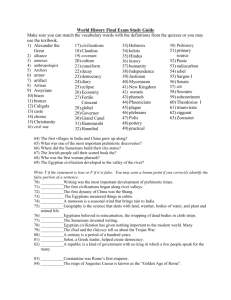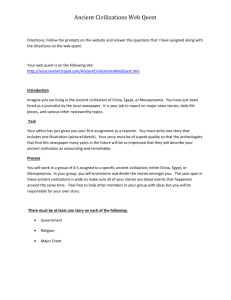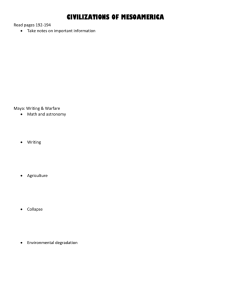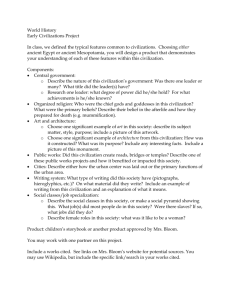Notes Chapter 3 First Civilizations
advertisement
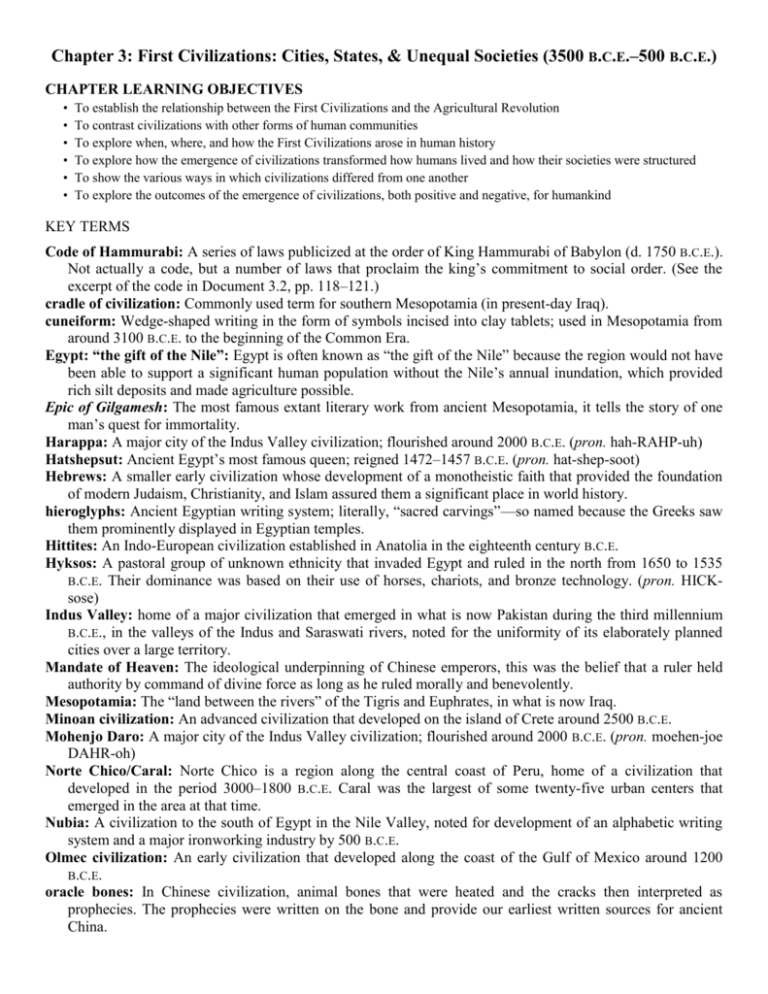
Chapter 3: First Civilizations: Cities, States, & Unequal Societies (3500 B.C.E.–500 B.C.E.) CHAPTER LEARNING OBJECTIVES • • • • • • To establish the relationship between the First Civilizations and the Agricultural Revolution To contrast civilizations with other forms of human communities To explore when, where, and how the First Civilizations arose in human history To explore how the emergence of civilizations transformed how humans lived and how their societies were structured To show the various ways in which civilizations differed from one another To explore the outcomes of the emergence of civilizations, both positive and negative, for humankind KEY TERMS Code of Hammurabi: A series of laws publicized at the order of King Hammurabi of Babylon (d. 1750 B.C.E.). Not actually a code, but a number of laws that proclaim the king’s commitment to social order. (See the excerpt of the code in Document 3.2, pp. 118–121.) cradle of civilization: Commonly used term for southern Mesopotamia (in present-day Iraq). cuneiform: Wedge-shaped writing in the form of symbols incised into clay tablets; used in Mesopotamia from around 3100 B.C.E. to the beginning of the Common Era. Egypt: “the gift of the Nile”: Egypt is often known as “the gift of the Nile” because the region would not have been able to support a significant human population without the Nile’s annual inundation, which provided rich silt deposits and made agriculture possible. Epic of Gilgamesh: The most famous extant literary work from ancient Mesopotamia, it tells the story of one man’s quest for immortality. Harappa: A major city of the Indus Valley civilization; flourished around 2000 B.C.E. (pron. hah-RAHP-uh) Hatshepsut: Ancient Egypt’s most famous queen; reigned 1472–1457 B.C.E. (pron. hat-shep-soot) Hebrews: A smaller early civilization whose development of a monotheistic faith that provided the foundation of modern Judaism, Christianity, and Islam assured them a significant place in world history. hieroglyphs: Ancient Egyptian writing system; literally, “sacred carvings”—so named because the Greeks saw them prominently displayed in Egyptian temples. Hittites: An Indo-European civilization established in Anatolia in the eighteenth century B.C.E. Hyksos: A pastoral group of unknown ethnicity that invaded Egypt and ruled in the north from 1650 to 1535 B.C.E. Their dominance was based on their use of horses, chariots, and bronze technology. (pron. HICKsose) Indus Valley: home of a major civilization that emerged in what is now Pakistan during the third millennium B.C.E., in the valleys of the Indus and Saraswati rivers, noted for the uniformity of its elaborately planned cities over a large territory. Mandate of Heaven: The ideological underpinning of Chinese emperors, this was the belief that a ruler held authority by command of divine force as long as he ruled morally and benevolently. Mesopotamia: The “land between the rivers” of the Tigris and Euphrates, in what is now Iraq. Minoan civilization: An advanced civilization that developed on the island of Crete around 2500 B.C.E. Mohenjo Daro: A major city of the Indus Valley civilization; flourished around 2000 B.C.E. (pron. moehen-joe DAHR-oh) Norte Chico/Caral: Norte Chico is a region along the central coast of Peru, home of a civilization that developed in the period 3000–1800 B.C.E. Caral was the largest of some twenty-five urban centers that emerged in the area at that time. Nubia: A civilization to the south of Egypt in the Nile Valley, noted for development of an alphabetic writing system and a major ironworking industry by 500 B.C.E. Olmec civilization: An early civilization that developed along the coast of the Gulf of Mexico around 1200 B.C.E. oracle bones: In Chinese civilization, animal bones that were heated and the cracks then interpreted as prophecies. The prophecies were written on the bone and provide our earliest written sources for ancient China. patriarchy: Literally “rule of the father”; a social system of male dominance. pharaoh: A king of Egypt. The term literally means “the palace” and only came into use in the New Kingdom, but it is generally employed in reference to all ancient Egyptian rulers. Phoenicians: A civilization in the area of present-day Lebanon, creators of the first alphabetic writing system. pyramid: Monumental tomb for an Egyptian pharaoh; mostly built during the Old Kingdom (2663–2195 B.C.E.). Pyramids are also found in Meroë to the south of Egypt. quipu: A series of knotted cords, used for accounting and perhaps as a form of writing in the Norte Chico civilization. rise of the state: A process of centralization that took place in the First Civilizations, growing out of the greater complexity of urban life in recognition of the need for coordination, regulation, adjudication, and military leadership. salinization: The buildup of minerals in soil, decreasing its fertility; can be caused by long-term irrigation. Sanxingdui: An ancient city of China that developed independently from the Shang dynasty. (pron. sahnshingdwee) Shang dynasty: Period of Chinese history from 1766 to 1122 B.C.E. (pron. shahng) Son of Heaven: Title of the ruler of China, first known from the Zhou dynasty. It acknowledges the ruler’s position as intermediary between heaven and earth. Teotihuacán: The largest city of ancient Mesoamerica; flourished around 500 C.E. (pron. teh-o-tee-WAH-kahn) Uruk: The largest city of ancient Mesopotamia. (pron. OOH-rook) Xia dynasty: A legendary series of monarchs of early China, traditionally dated to 2200–1766 B.C.E. (pron. shah) Zhou dynasty: Period of Chinese history from 1122 to 256 B.C.E. (pron. joe) ziggurat: A Mesopotamian stepped pyramid. Unlike an Egyptian pyramid, a ziggurat was a solid structure of baked brick, an artificial hill at the summit of which stood a temple. BIG PICTURE QUESTIONS 1. What distinguished civilizations from other forms of human community? 2. How does the use of the term “civilization” by historians differ from that of popular usage? How do you use the term? 3. “Civilizations were held together largely by force.” Do you agree with this assessment, or were there other mechanisms of integration as well? 4. In the development of the First Civilizations, what was gained for humankind, and what was lost? Margin Review Questions 1. When and where did the First Civilizations emerge? 2. What accounts for the initial breakthroughs to civilization? 3. What was the role of cities in the early civilizations? 4 . In what ways was social inequality expressed in early civilizations? 5. In what ways have historians tried to explain the origins of patriarchy? 6. How did Mesopotamian and Egyptian patriarchy differ from each other? 7. What were the sources of state authority in the First Civilizations? 8. In what ways did Mesopotamian and Egyptian civilizations differ from each other? 9. In what ways were Mesopotamian and Egyptian civilizations shaped by their interactions with near and distant neighbors?


